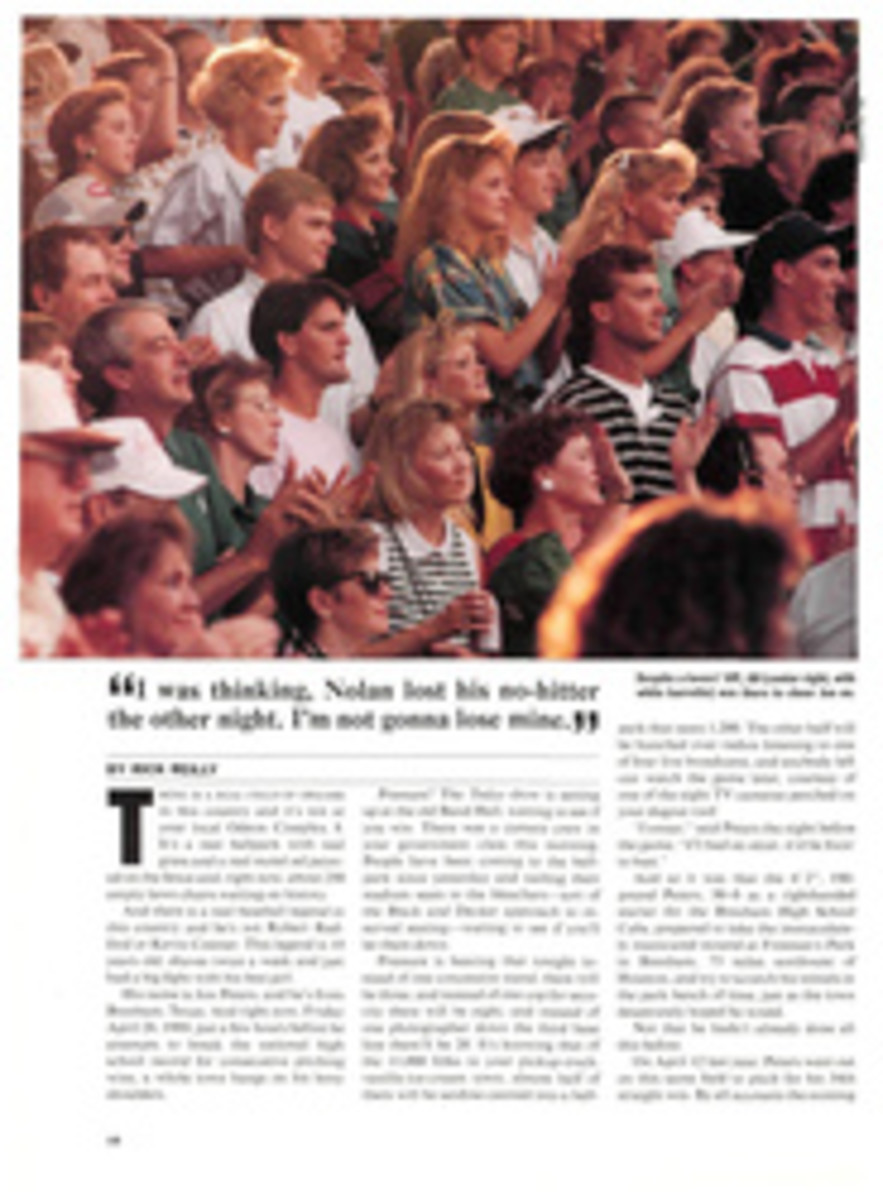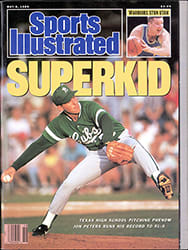
THEY FLY THROUGH THE AIR WITH THE GREATEST OF EASE
When members of the world champion Ultimate Frisbee team—officially known as New York Ultimate—stepped off the plane in San Diego the day before Thanksgiving, their mood was, well, confident. "No," says Pat King, the on-field leader of the 22-man unit, "we were justifiably arrogant."
After a year of unparalleled success, they had flown west to defend their national title against 11 other top teams from across the country. It was widely agreed that the New Yorkers might be the best team ever to play the seven-on-seven game; at the very least they were odds-on favorites to become the first team to win back-to-back U.S. titles.
In the preceding 12 months, the New Yorkers—an oddball collection including lawyers, commodities traders, bankers, engineers and a carpenter—had dominated their opponents on their way to every major title in the sport, including the world championship played last September in Louvain, Belgium. Their eminence was hard-earned: seven-days-a-week practice sessions on rough park fields in and around New York City had turned them into aerobic dynamos, known for their in-your-face D and explosive O. "You have to be fit to play Ultimate," says King, "because in a championship-level game, it's like running continuous 440s."
For most Americans, Frisbee is something played on a sunny day, preferably near a beach or with your dog. Sweating is not usually a component of the sport. But when club teams—and growing numbers of college, high school, corporate and summer league teams—play Ultimate, the resulting melee requires that a player have the quickness of a basketball point guard, the finesse of a hockey center, the blocking techniques of a football guard and the reactions of a soccer goalie. A willingness to hit the dirt—teeth first, without pads—is essential. So is the ability to arc a 165-gram Wham-O Frisbee flying disc 50 yards with the flick of an overhand, a backhand or an overhead toss.
One week before the 1988 national championships, Ken Dobyns, 26, the New Yorkers' emotional leader, said, "Our goal is to win back-to-back nationals, but we never realized how tough that would turn out to be. Last season we put everything except Frisbee on the back burner. This year it's been tougher to stay focused."
That lack of focus almost derailed their dream at September's world championships. Going into the 16-team, week-long tournament in Belgium, the New Yorkers knew that Sweden, a government-funded all-star team with a full-time paid coach, would be their toughest competition, but as they watched the Swedes lose a sloppy game to the Finns, their cockiness returned.
"The night before we were to play the Swedes we stayed out and partied, had a good time," admits King. "And we almost ate plates full of crow." The Swedes, who had studied videotapes of the New Yorkers, led 16-14 in a game that was to end at 17 (with a two point lead). The shocked New Yorkers rallied for four straight goals and a slim semifinal victory. "We kept expecting them to crumble but they never did," says King. "Since they had been beating us with their running game, we threw a zone on them, blocked a couple of big passes and scored a couple of times quickly. That saved the day." Lesson learned, the New Yorkers routed the Finns 21-8 to win the world title.
Ultimate Frisbee was first played in a parking lot in Maplewood, N.J., 21 years ago; it gained popularity on college campuses in the early 1970s. The game is played in two halves with goals scored by passing the disc to a player in the 25-yard-deep end zone of a 70-by 40-yard field. If the Frisbee hits the ground or soars out-of-bounds, it changes hands. Field-length bombs are a rarity in topflight competition; scoring is more often the result of pinpoint, short passes. It is not unusual to take 50 passes to work the Frisbee upfield. The best teams have elaborate offensive and defensive strategies. But while accurate throws and one-handed grabs are the game's focal point, the ability to sprint, cut, dive and play defense are its basis. Not surprisingly, Ultimate Players Association (UPA) executive director Rob Rauch, 30, who is also a member of the New York team, gets letters every week from high school and college phys-ed coaches who see Ultimate as a great cross-training sport.
"The primary difference between Ultimate and other team sports I have played is the endurance factor," says King, 30, who played football and lacrosse at Dartmouth. "In the course of one point you're running continuously for three or four minutes at a near-sprint. What makes a player great is when, at the end of a long point and there's a turnover, he can still sprint down the field. Usually that leaves the man covering him crying."
Most members of the New York team had played for either Kaboom! or Spot (as in "run, Spot, run"), two rival teams from which the best players were selected in 1987 to form a new team. The New Yorkers' record going into the tournament was 136-9. But as happens to champs in every sport, the New Yorkers' winning streak meant that every team they faced was gunning for them. The result: closer, rougher games and a growing animosity toward the New Yorkers. Their display of "justifiable arrogance" was often hard to take.
Despite Ultimate's aerobic value and the continued growth of the UPA, which has almost 6,000 members nationwide, the game remains something of an outsider in the realm of sport, although most of its players these days seem to be yuppies. Ultimate is self-governed, with few coaches, managers or sponsors and no referees. Players pay their own way to tournaments and provide their own uniforms (the world champs wear a variety of black T-shirts, most bearing a rapping Mickey and Minnie Mouse, which they bought on a street corner for $3 apiece). But there has been talk of trying to attract sponsors and TV coverage.
"We have even thought about an Arena Football-type league, featuring a dozen of the best teams from across the country," says Rauch, "which would be great if we played over a short, three-or four-month season. It wouldn't require much of an investment beyond new uniforms, and it would help us gain some recognition. But recognition isn't really important to most of the players. It's the camaraderie, the competition, the fitness and the beer drinking that attract people to Ultimate, not fame. And certainly not money."
The San Diego tournament began with a bang for the New Yorkers. Undefeated through pool play, they beat archrival Windy City (from Chicago, natch) 19-13, turning the disc over only twice the whole game.
In the semifinals they faced South Bay, a band of experienced northern Californians. In a game to 21, the New Yorkers led 18-15 and appeared to be coasting to a face-off in the finals against Boston's Titanic, which they had beaten handily in the regionals. A California-biased crowd of 1,500 had gathered in Balboa Stadium to cheer on the South Bay squad. Then, the inexplicable happened. The New Yorkers' hands turned to stone, their defense to Swiss cheese and their feet to cement. South Bay scored six uncontested goals and beat the New Yorkers 21-18 and went on to win the national title.
Ironically, it may have been the New Yorkers' "justifiable arrogance" that felled them. "They were pretty cocky during the game," says South Bay's Heyward Robinson, "and the sidelines were definitely on our side. We wanted to beat them, though it doesn't happen often, just to bring them down a notch." Robinson calls the New Yorkers the "smartest team" on the Ultimate field, but adds that that can be a liability. "While they have pushed the game to new levels by the number of plays they run and the sophistication of their offense," he said, "they may have developed the game into too much of a science. You need emotion to win, too, and I think that cost them. Their game was a little too planned. When they lost, they weren't angry, they were stunned."
The New Yorkers put the San Diego debacle behind them and started the new year by winning a tournament in Tempe, Ariz. "It's not like life," says Rauch, "where your losses haunt you forever. There's always another game."
PHOTO
CHUCK SOLOMON
New York Ultimate's Skip Kuhn makes a diving catch.
PHOTO
CHUCK SOLOMON
Rauch, a banker, says fitness and beer bring people to Ultimate.
Jon Bowermaster is a New York free-lance writer who specializes in outdoor sports.

